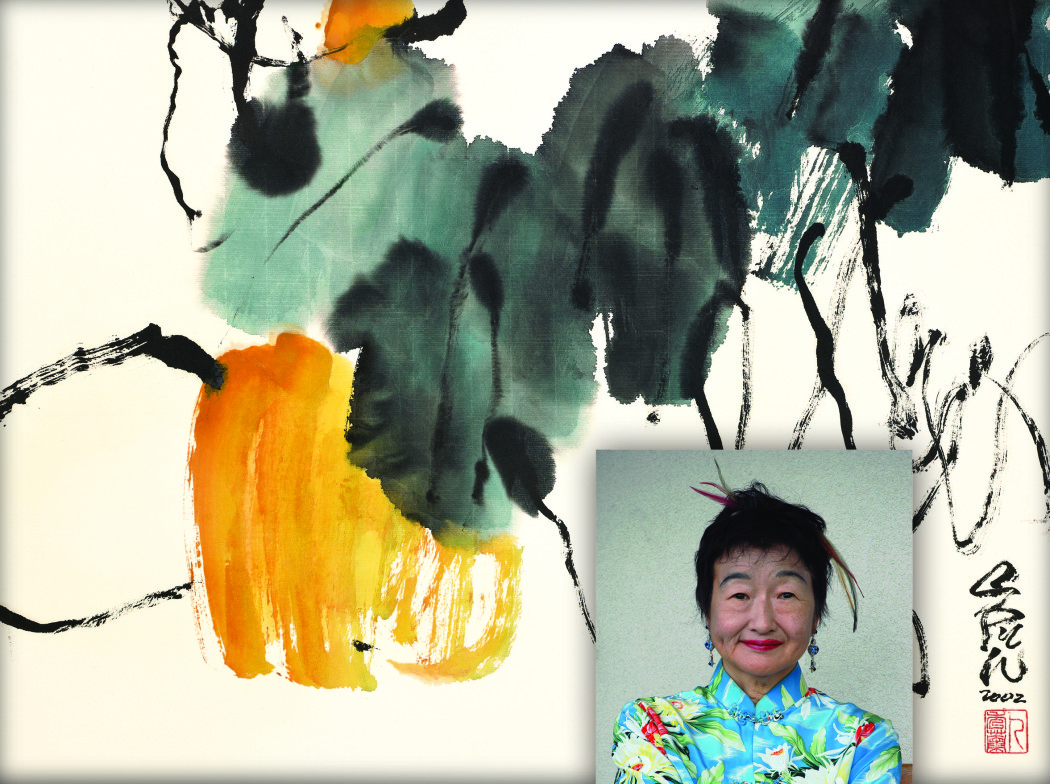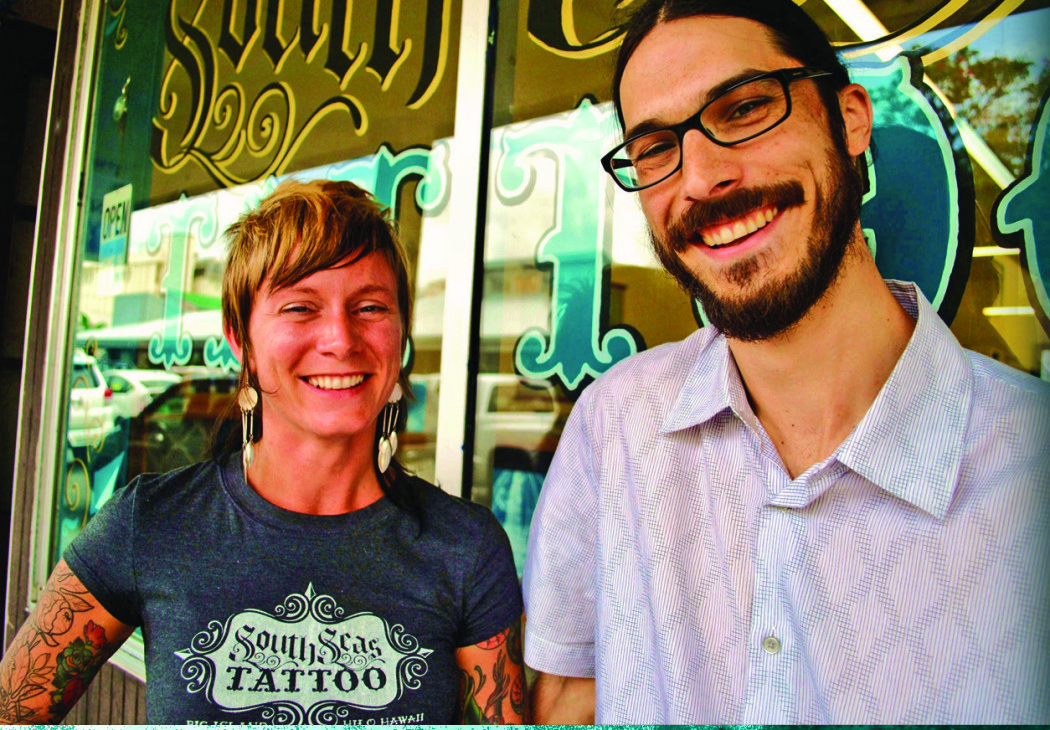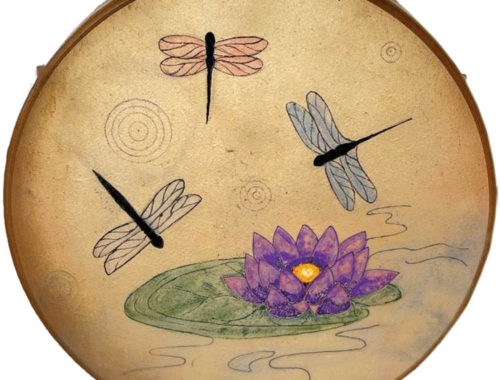
A Master Chinese Brush Painter: Shirley Pu Wills Practices the Art of Imagination and Chi
 By Fern Gavelek
By Fern Gavelek
It’s both what you see and what you don’t see that create the magic in Chinese brush painting.
“The thing about Chinese brush painting is you imagine what’s not there,” says Shirley Pu Wills of Captain Cook. “A painting of koi fish has no depiction of water…yet, you know the water is there because the fish are so fluid-like.”
The accomplished and award-winning Chinese brush painter relies on her Asian roots for her artistic foundation and the dynamic beauty of living things for her inspiration.
Born of Chinese heritage in Post-World War II Japan, Shirley’s initial exposure to art was the precision, order and aesthetics in Japanese food and gift presentation, textile design and flower arrangement. Showing an aptitude for drawing as a toddler, the young Shirley held her first brush at the age of 4 under the tutelage of a Japanese sumi-e instructor.
A style of minimalist brush painting, sumi-e uses a combination of water and ink. The style originated from the Chinese Sung Dynasty, 960-1279 AD, and, according to Shirley, the words “su” and “mi” come from the Chinese words “sui” for water and “mo” for ink.
While sumi-e captures the essence of an object in the fewest possible strokes, Shirley says her Chinese brush painting is more than that, involving precise—and often many—brush strokes in a combination of styles. While the path to Shirley’s chosen art form has involved living in several cultures and time zones, the South Kona resident takes pride in using age-old and contemporary Chinese techniques and tools for her art.
Having been educated in the ways of Eastern cultures, the soft-spoken and reserved Shirley experienced culture shock when her family relocated to New York City in 1958. The move to the other side of the globe meant the 7-year-old needed to quickly learn English and the American way of life. Often feeling isolated, Shirley found familiarity in art and immersed herself in doing all kinds of painting. “I found a way to connect to the world through art,” she smiles.
For more than 10 years, Shirley studied brush painting in New York City with Chinese masters who were non-English speaking immigrants. “Listening and again speaking” her native tongue of Shanghainese while she learned the ancient art form, Shirley experienced a Chinese cultural revitalization. She was able to paint from her inner truth and honor who she had become.
At the same time, she also developed skills that would lead to a career in commercial art. As a teen, Shirley won a scholarship to Manhattan’s Fashion Institute of Technology, where she studied portraiture and illustration. After earning a BFA degree in contemporary painting and art education at the Pratt Institute, the young woman answered a New York Times classified ad looking for a fashion illustrator.
“This was the most exciting time in my life,” recalls Shirley. The 27-year-old was interviewed in Washington, D.C., and then flown to Polynesia to work for Liberty House in Honolulu. She stayed in Hawai‘i for three years, relishing the beauty of the tropics and visiting all the islands. At Liberty House, she created “fashionable drawings of dressed female figures” for advertising campaigns. However, Shirley missed her parents and moved back to the East Coast in the early 1980s, settling in New Jersey. There, she married David Wills, now her ex-husband.
The marriage afforded Shirley time to develop a painting career and return to her roots. She explains, ”While in Honolulu, I had rediscovered my Chinese heritage and culture through the late Master Lam Oi Char (artist) at the University of Hawai‘i. I looked further and approached Chinese brush painting as a way to re-connect with my roots as art is my life; it’s what I’m all about.”
Describing her creative muse, Shirley says, “Images come from deep within my consciousness, where dreams flourish, and through my heart, my limbs and fingers. Yielding my brush, I impart my songs from my soul and lay them upon paper.”
Shirley’s efforts at refining her skills paid off. She acquired a well-known reputation as “New Jersey’s Floral Chinese Brush Painting Artist.” She was soon winning awards and represented by the Phoenix and Ceries Gallery through the Asian American Women’s Artists Alliance—a group she co-founded. Relying on her background in art education, the popular brush painter also became a sought-after instructor, teaching at the prestigious China Institute in Manhattan, New Jersey’s Drew University and SUNY, the State University of New York.
Shirley says she incorporates two styles into her brush paintings. In the elaborate or linear style, fine lines and soft gradations of dual colors convey meticulous details. The spontaneous style involves more expressive line quality and less detail, emoting impressionistic statements to capture the essence and spirit of the subject matter. “I sometimes work back and forth between the styles and combine them into one piece of work,” she adds.
The technique of applying the brush stroke to paper is key to Chinese brush painting, as is the type of brush and paint or ink used. Shirley describes it as “a very precision-orientated and controlled painting style.”
She explains: “The Chinese Brush has a big belly that holds a lot of water and paint. The side of the brush is used to do strokes of thick stalks while the point of the brush, with varying pressure, will paint leaves of the bamboo. Speed of stroke, the exact amount of water and color, and dancing with the brush with minimal amount of strokes are all the ingredients of a well-mastered piece of artwork.”
The artist emphasizes the brush must be held vertically. This allows easy movement of the wrist and swirling of the entire arm so the “chi” (energy or spirit) flows throughout the entire body.
The traditional tools for Chinese brush painting are called the Four Treasures of the Scholar. They include rice paper, brush, ink stone (originally soot, charcoal or pine resin) and ink slab, where water is combined with black to get various shades of gray. Shirley employs some of the ancient tools and contemporary versions of the originals.
She has 100 different-sized brushes that vary in softness and stiffness, and she uses Chinese painting colors. Shirley explains, “The thick pigment comes straight from the tube and in its dry-brush form has a pastel-like effect. When water is added, the result is an oil painting quality and most times, with more water, it becomes transparent watercolor.”
“I use lots of magenta colors in my paintings,” she continues. Instead of traditional black resources like charcoal, the brush painter uses bottled black ink. In addition to porous rice paper, Shirley also paints on champagne and gold-colored silk mounted on archival foam board because she finds the medium “holds up better in the humid tropical climate of Hawai‘i.”
Shirley returned to live in Hawai‘i in 2003. At that time, she relocated to Kona and was surprised people on Hawai‘i Island hadn’t heard of her art. Resigned to “start over from scratch,” the artist shared her Chinese brush paintings on rice paper at the Waimea Cherry Blossom Heritage Festival and did a solo show at the East Hawai‘i Cultural Center. Her popularity grew as she appeared in juried art shows and taught large classes at Holualoa’s Donkey Mill Art Center. Today, Shirley’s art can be found at Third Dimension Gallery at the Shops at Mauna Lani, the Gallery of Great Things in Waimea and Rumley Art and Frame Gallery in Kailua-Kona.
Returning to the islands has provided inspiration for Shirley, who likes to paint the living things she sees in gardens, like flowers, birds—most recently peacocks— and multicolored koi fish.
“I have a real feel for flowers because they’re alive, like human flesh—breathing and containing moisture,” Shirley states. “As a Chinese brush painter, I try to breathe life into my paintings by capturing the subject’s liveliness and its temperament.” She says it’s like imparting “the spirit or essence” of the subject into
the painting.
The artist enjoys incorporating Chinese cultural themes into her artwork. The large peony blossom is a favorite subject as it symbolizes prosperity. The lotus appears in many of her paintings too.
“In nature, the roots of a lotus are in the mud, the stem grows up through the water and the heavily scented flower lies pristinely above the water, basking in the sunlight,” explains Shirley. “In Buddhism, this pattern of growth signifies the progress of the soul from the primeval mud of materialism, through the waters of illusion and into the air of self-realization and enlightenment.”
One of her paintings, “Nine Fantail Koi Fish Swimming Upstream,” illustrates the Eastern myth of achieving success. According to legend, the koi swam up a stream and climbed a waterfall, turning them into a dragon, a strong and powerful creature in Chinese mythology (2012 is the Chinese Year of the Dragon). The myth is a metaphor for the idea that man can achieve his success if he meets his challenge.
The painting depicts colorful koi swimming upstream and gaining momentum, like a man attempting to overcome all obstacles to reach his goals. While there is no waterfall in the painting, it is imagined, along with the vision of the fish flying to climb the cascade, twisting and turning to converge and become a
mighty dragon.
Shirley describes the painting’s symbolism, “Fish denote wealth and the pronunciation for ‘nine’ in Chinese is the same word for ‘everlasting.’ So the subject represents the idea that man can achieve everlasting wealth in many aspects: health, wisdom, prosperity and the riches of having many friends.”
Feeling “art is close to one’s personal, spiritual manifestation,” Shirley recently gifted Sam Choy with two floral paintings. See them near the entrance of his new Keauhou restaurant, Kai Lanai.
“The Chinese literati’s paintings were not commercially oriented, they were given out of respect for others and as an indication of honor,” she says. “After I got to know Sam, I gave him this gift in the same scholarly tradition.”
Chinese brush paintings by Shirley Pu Wills are available as prints, giclees and originals priced from $35 to $12,000. Private instruction can be arranged by phoning 808.936.6291. For more info, visit www.shirleypuwills.com.


